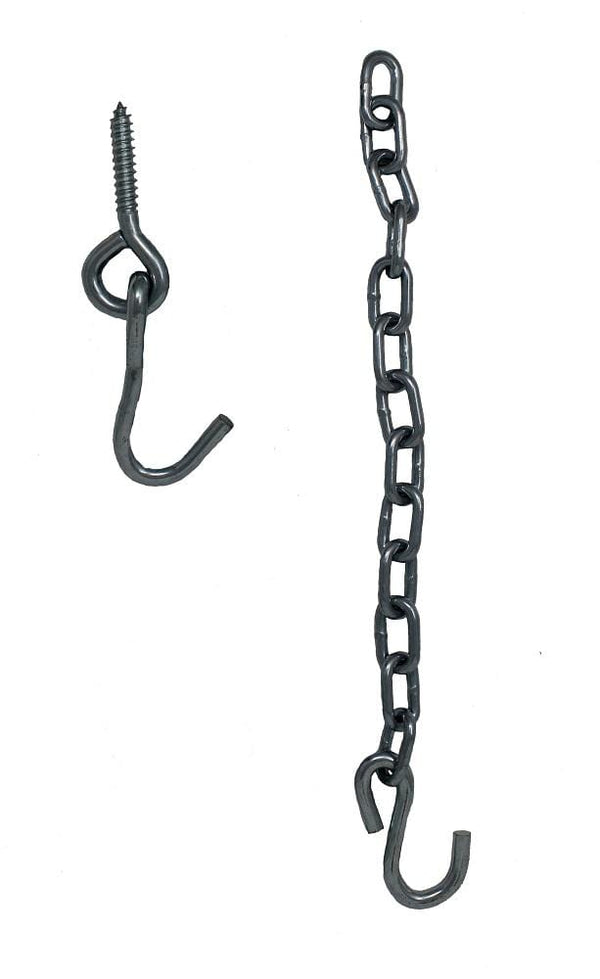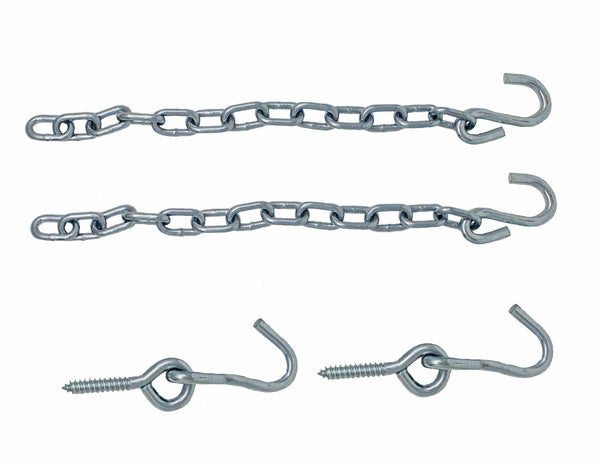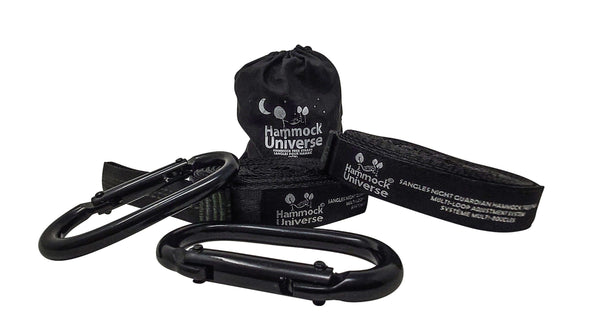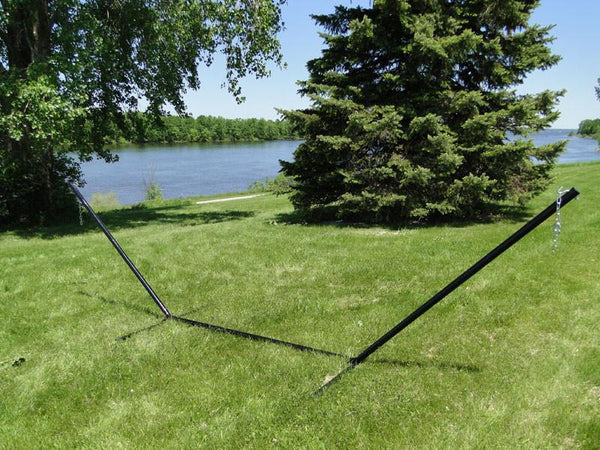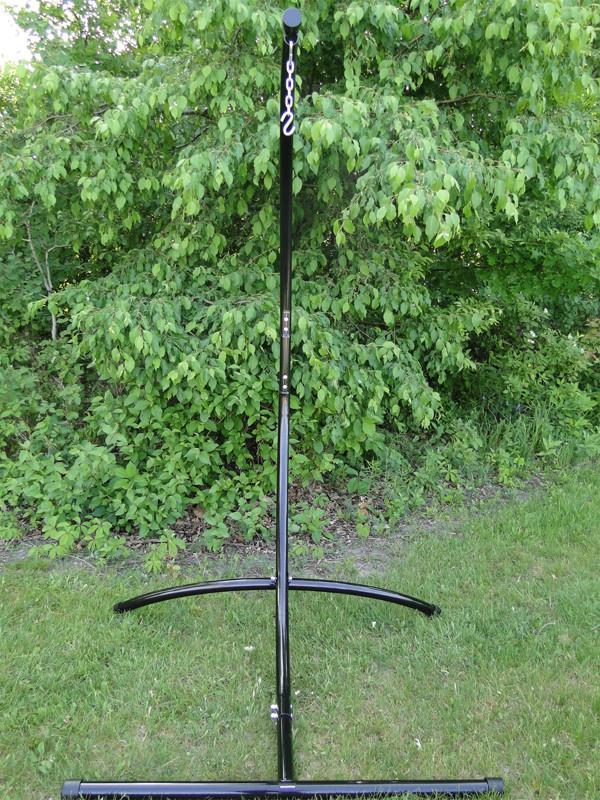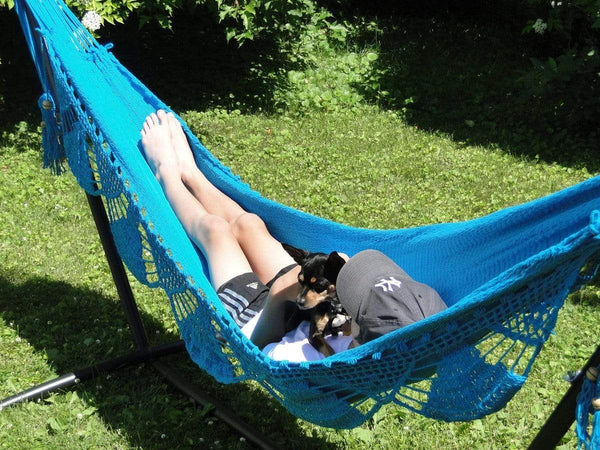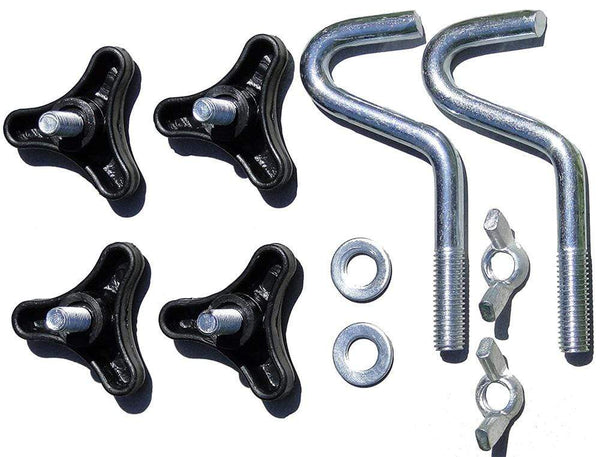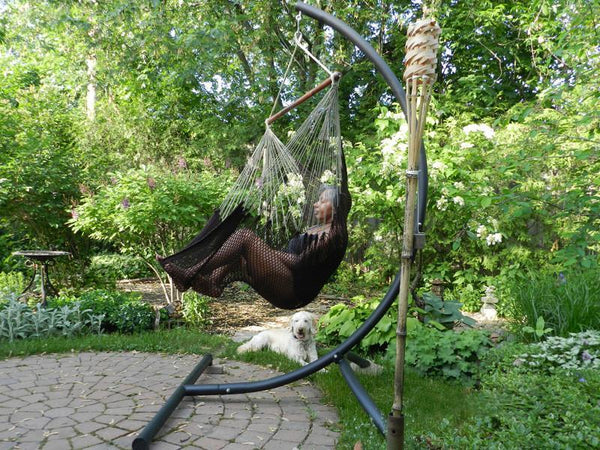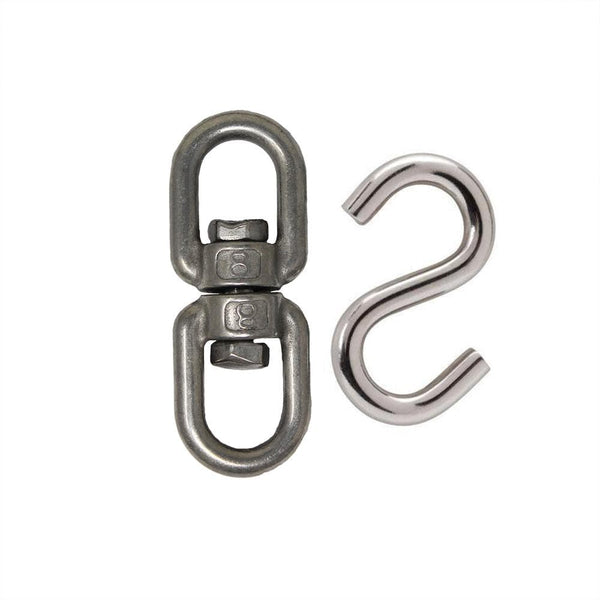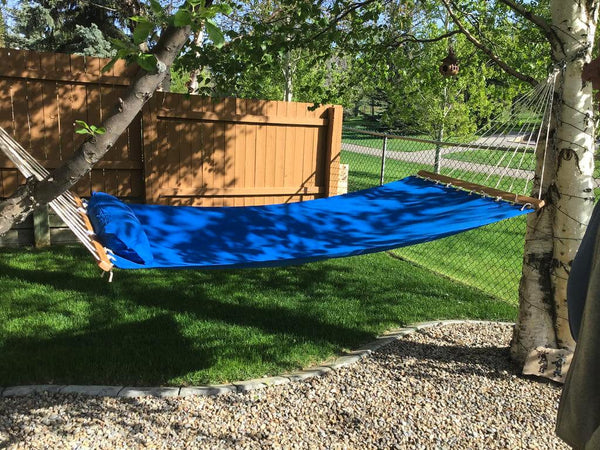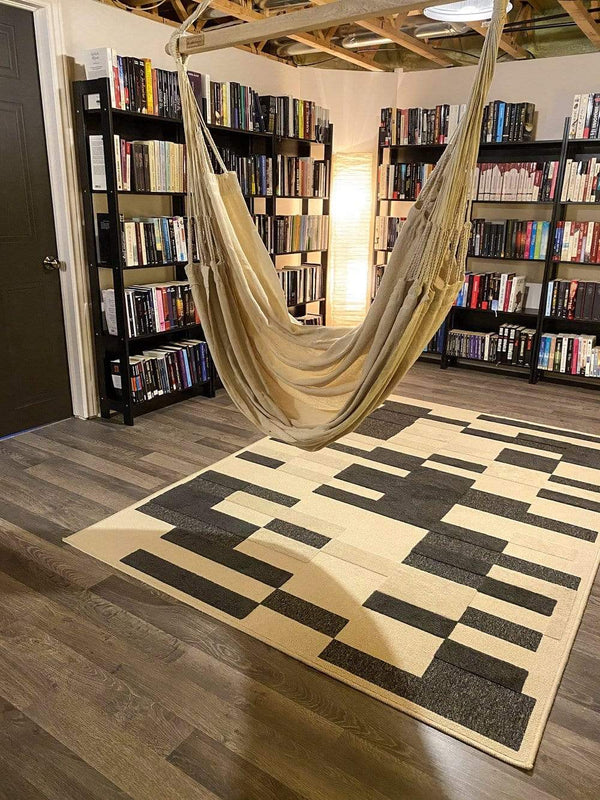FREE SHIPPING on most orders $25+ HAMMOCK BUYING GUIDE
Menu
-
-
Hammocks
-
Hammock Stands
-
Hammocks with Stands
-
Hanging Hammock Chairs
- View all Hammock Chairs
- Brazilian Style Hammock Chairs
- Colombian Hammock Chairs
- Mayan Hammock Chairs
- Mayan Hammock Chairs Deluxe
- Universal Hammock Chair Stand
- U Hammock Chair Stand
- Brazilian Hammock Chair with Universal Chair Stand
- Colombian Hammock Chair with Universal Chair Stand
- Mayan Hammock Chair with Universal Chair Stand
- Mayan Hammock Chair Deluxe with Universal Stand
-
Accessories
- Gift Cards
- Tools and Guides
- Bargain Bin
-
- 1-800-207-4761
- Login

FREE SHIPPING on most orders $25+ HAMMOCK BUYING GUIDE
How to Hang A Hammock Indoors
May 29, 2019 9 min read

A Look at the Methods for Hanging Your Hammock Indoors and Important Safety Measures You Should Take
People often think of hammocks as an exclusively outdoor way to relax. Whether between trees in a backyard or at the lakeside, most hammock owners eagerly anticipate summer weather to start hanging out in their hammocks outside.
But hammocks aren’t exclusive to the great outdoors. You can hang your hammock (almost) anywhere in your home and enjoy it throughout the year, in rain, snow, or sunshine.
Sun rooms, living rooms, as a replacement for your bed… hanging a hammock indoors gives you plenty of options for use. Plus, they’re a great way to relax while taking stress off your back; hammocks actually prevent tossing and turning, and, depending on the style you choose, can even “cocoon” you for an incredibly restful sleep.
Best of all, as long as you anchor them properly, hammocks can be hung almost anywhere in your home. And if you don’t feel like taking measurements and drilling holes in your walls, consider a reliable stand to use in your home.
Let’s take a closer look at suspension methods and locations to help you get the most out of indoor hammock use.
Suspension: What, Where, and When to Use It
Hardware Suspension
Heavy-duty hardware, like eye bolts, screw eyes, j-hooks, and s-hooks are used as secure anchor points in wall beams and ceiling joists. These hardware types may also secure hammocks between posts. Hardware suspension will require a bit of additional work on your end. You must find secure supports within your home with a stud finder and take a bit of extra care when installing the appropriate hardware.
It's important to avoid using metal studs during this procedure. If you anchor heavy objects in metal studs (like those found in large-scale apartment buildings) you risk bending and damaging the studs, causing structural damage that could be costly to fix. To ensure a safe and secure suspension, stick to wooden studs when hanging your hammock.
Chains
Chains are secure, heavy-duty suspension materials that are easily adjustable when using s-hooks. You can move the s-hook up and down the chain to adjust the tension of your hammock. Plus, metal chains are extremely durable. You won’t have to worry about them wearing down from weight over time.
Rope and Cords
While rope and cords are great for hanging hammocks outdoors on trees, you can also use rope as suspension for indoor hammocks. Again, as with a standard outdoor hammock, you’ll have to know how to tie a tight and secure knot. If you’re not experienced with safe and secure knot-tying techniques, you’re better off sticking with chains for your indoor hammock suspension.
Hammock Stands
Hammock stands are the easiest way to hang a hammock, indoors and out. You can move the stand and hammock wherever you please. Plus, there’s no need to worry about measuring, tying intricate knots, or securing hardware to load-bearing beams.
While you wouldn’t want to take a hammock stand with you while camping, these stands do make for attractive and useful pieces of furniture at home. The only downside is that a hammock stand has a larger physical footprint that you’ll have to account for.
Materials you’ll need
Indoor hammock hanging is made easy when you make a list, make measurements, prep the hanging area, and get your materials together! Here’s a list of materials you’ll need:
- Your favourite hammock or hammock chair
- Measuring tape
- Stud finder
- Electric drill with drill bits
- Chains
- Eye hooks (⅜-inch - must support 300 lbs with a thread at least 4-inches long)
- Two link chain connectors (carabiners, s-hooks – must support 300 lbs)
- Screws
- Pencil to mark drill points
5 Things to Take into Consideration
Now that you’ve got your materials ready to go, it’s time to consider how you want to configure the space you plan on hanging your hammock in and other essential factors that will contribute to your relaxation.
You’ll want to maximize comfort without sacrificing accessibility, room functionality, and most importantly, safety.
Take the following into consideration before hanging a hammock indoors.
*Note: If you have a hammock chair, you can skip to number 4 on this list!
1. Distance Between Two Objects
Just as you would scout a good set of trees to hang your hammock from, you’ll have to examine your room to determine the best angle and distance for your indoor hammock.
You don’t want these points so far apart that you’re left with a long, awkward length of chain from either end of the room (not to mention an eyesore), but you also don’t want to confine yourself to a small corner.
When determining this space – think: What would Goldilocks do?
You want a distance that’s just right when it comes to setting up your hammock indoors, not just for your own comfort but for room accessibility as well – this is something we’ll get into a little further down in point #4.
If you have a hammock chair and decided to read numbers 1-3 anyway: When it comes to hammock chairs there isn’t as much “scouting” happening here. All you really need to do is pick a spot on the ceiling that has a stud.
2. Height of Attachment Points
A great thing about indoor hammock hanging is that you don’t really need to educate yourself on how to tie complicated knots or learn how to use straps properly so you don’t fall to the ground.
Hanging a hammock indoors requires hardware-based hammock suspension for your walls or ceiling. They’re relatively straightforward to use and don’t require scout skills as a prerequisite.
For hammock chairs, this is a no-brainer—you’re installing the eye hooks directly into a stud in the ceiling.
For all other hammocks, you’ll want to determine how high you want your attachment points based on your chain length, hammock size, and room functionality.
A good thing to remember when hanging your hammock indoors is that the closer you hang the eye hooks to each other, the higher your hammock will need to be from the ground.
3. Ridgeline Length
The amount of curve in your hammock, also known as sag, is determined by the distance between both ends of the hammock once it’s set up. This space is most commonly known as the hammock ridge length and can easily be figured out by measuring the distance between both ends of your hammock.
The ideal ridgeline length is about 8-9 feet (96-108 inches), this allows for optimal sag in your hammock—this also plays a role in hammock height!
4. Room Accessibility (hammock placement)
Hammocks elevate almost any living space, but you shouldn’t just install it anywhere. Think about the purpose of the hammock: what you plan on doing while you relax.
Are you looking for a place to nap? A reading nook? A place to watch tv or play video games? A place for your child to play?
The functionality of the hammock will come into play when it comes to the setup of your room and placement of the hammock.
Read More: Hammock Décor Ideas
Once you’ve determined the primary use for your hammock, optimize your space. Your hammock will be a focal point in the room, so get it in the right position, throw in some accents and accessories, and set up the surrounding area with all your essentials that will elevate the space.
5. Hammock Height
Without any weight in the hammock, the optimal height of the hammock ends from the floor is about 67 inches or 5.75 feet. Again, with no weight in the hammock, the distance from the seat to the floor should be about 12 to 30 inches, or 1 to 2.5 feet.
Since a hammock chair is installed in the ceiling, it makes it extremely easy for you to adjust the distance between the bottom of the chair and the floor.
Once you’ve installed the hardware, you’ll want to measure the chair length, the length from the ceiling to the floor and find the difference (recommended for A-types), or, for all you B-types out there, you can use the trial and error method.
When it comes to traditional hammocks, this process is a little different (i.e. less measuring). Based on the height of your attachment points, you’ll simply need to readjust the ridgeline.
Remember, a simple but useful rule of thumb to follow when it comes to hammock height is never to install it above the height you’re willing to fall from.

Indoor Hammock Hanging Safety Concerns
It’s no surprise that hanging a hammock between walls or on the ceiling can be dangerous. A big safety concern is to ensure you absolutely, under no circumstances hang your hammock in drywall alone. That’s a given. You must first find the stud behind the drywall and drill into that exact spot.
Studs run along the wall vertically, so as long as you're within the area from top to bottom, you're securing your hammock in the right spot. It's always a good idea to use the stud finder a few times over the spot you intend to drill into.
Always look for studs and use a-grade hanging materials that can support at least 300 pounds. That means no aftermarket s-hooks, flimsy chains, or old rusty screws you found in the garage.
Read More: Hammock Safety Tips for Children and Parents
Check the Tension Weight Limits
After installing the hardware into the studs, hang the chains and give them a firm tug. Do this a few times to determine how secure they are. Once you’re satisfied, it’s time for the fun part—hang and test your hammock!
Test Out Your Hammock
Once you’ve secured your hammock to the wall or ceiling by following the steps below, we recommend testing its weight capacity and the integrity of your work (no offence).
Pile on some books, weights, etc. to test out your hammock. Once you’ve determined that it’s safe to use, get in with caution until you’re comfortable with the results of your work.
*Important Reminder: Always follow the instructions that come with your swing. Our hanging suggestions are an additional resource to help you throughout the process.
This next section will walk you through the steps on how to how to hang a hammock chair from the ceiling and how to hang a hammock indoors.
10 Easy Steps on How to Safely Hang A Hammock from The Ceiling
Hanging a hammock from the ceiling is a stylish and luxurious way to relax. That said, any suspension methods you use must be anchored to load-bearing ceiling beams, also known as ceiling joists. These beams are made of solid wood that make up the home’s framework. Load-bearing beams are designed to hold heavy weight in the house, and ultimately, hold the house together. They are also found in the walls, where they’re commonly known as wall studs.
Once you’ve chosen a room or area in your home where you’d like to hang your hammock, follow these steps to hang the hammock safely from your ceiling:
- Find the ceiling joists using a stud finder and mark the exact centre of the joist.
- Use a drill with a small bit to drill a hole into the joist. There should be small wood shavings on the bit if you've reached solid wood.
- Measure and mark the distance between the two anchor points. This could be anywhere between 10 and 15 feet. The exact distance depends on the length of your hammock and how much sag (loose curve) you want. Furthermore, consider the height of your hammock when hanging it. The ideal height is 18 inches from the floor, the average sit height of a chair.
- For the second anchor point, find the centre of the joist and drill another small hole.
- Drill 3/8-inch pilot holes into both anchor points.
- Screw in heavy-duty eye-bolts that are long enough to have at least 2 inches screwed into the solid wood joists.
- Attach chain, ropes, or cords to the end-loops of the hammock to get your desired length and sag.
- Hook these suspensions to the anchored hooks or eye-bolts with knots or carabiners.
- Adjust the length of the suspension to get the desired height and sag for your hammock.
- Try sitting and lying down in your hammock. If it’s comfortable, then you can start relaxing and enjoying your new indoor hammock.
These steps also apply for hanging a hammock between two walls, or from a ceiling anchor and a wall anchor. When hanging from walls, look for the wall studs using a stud finder, and anchor the bolts and screws into the studs.
Weight Support: What Material Should you Use, and Which Method Is the Most Secure?
Make sure to account for the amount of force applied to your anchor points and suspension while you relax in your hammock.
The amount of force is influenced by a combination of your weight and the angle of the suspension, or the angle between the chosen suspension method and anchor point.
Aim to hang with a suspension angle of about 30 degrees. This angle provides enough slack to securely hold your weight without applying too much force on the suspension and anchors.
If it’s too tight, climbing into the hammock will exert too much force on the suspension and anchor. This puts the anchors at risk of being pulled out, damaging the walls or ceiling, and setting you up for a fall. Plus, taut hammocks are uncomfortable!
Don’t limit your hammock use to a single season and location! Enjoy the best of both worlds by using a hammock when camping or relaxing in the backyard, and bring it indoors for even more relaxation throughout the year. What’s more, you might find you prefer your hammock to your bed, especially if you have trouble sleeping.
So make the most of hanging in hammocks, and use these tips to hang one securely in your home.
Safety First!
When using a hammock*, safety is paramount. Please make sure to follow these important guidelines when purchasing, installing and using a hammock
*(includes Hammock, Hammock Chair, Hammock Stand and Hammock Accessories)
Safety First!
When using a hammock*, safety is paramount. Please make sure to follow these important guidelines when purchasing, installing and using a hammock
*(includes Hammock, Hammock Chair, Hammock Stand and Hammock Accessories)
Related Products
Want to relax?
Join for exclusive content and promotions we only give to our email list!

